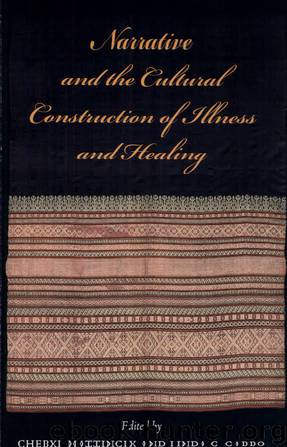Narrative and the Cultural Construction of Illness and Healing by Cheryl Mattingly & Linda Garro

Author:Cheryl Mattingly & Linda Garro
Language: eng
Format: epub
Published: 2015-03-13T16:00:00+00:00
Other dilemmas of particular relevance for narrative research include problems of translation and meaning for English-speaking audiences, story structures in different languages and how to represent them, and issues of the written representation of translated materials (e.g., translating a translated narrative). There is a creative element in all translations and in all representations of the spoken word.17
Extending the insights of Goffman 1963, my representation and interpretation of the narrative has emphasized women's agency in the face of stigma. Yet it is clear that Celine did not act alone. She cannot resist the master narrative for women in India by herself. Her husband's place in her resistance process cannot be ignored, even if uncertainty remains about his precise role. Nor does she state how her family's responses (p.145) may have enabled her actions. Narrative analysts never have the whole life story; we work with fragments.
To emphasize women's agency is not to minimize social structural factors. Research participants—investigators, translators/interpreters, and subjects—are constituted by the cultural and structural frameworks available to them, which provide the only way they have of interpreting their lives (or research materials). I have suggested some of the ways in which my social location and precommitments, and Liza's, influenced our respective interpretive processes and relationships with informants. Celine, too, has resources at her disposal to aid interpretation and action. As Sen (1999:xii) argues, “There is a deep complementarity between individual agency and social arrangements.”
Kerala—the regional setting for Celine's narrative and life—is unique in India (even South India). Women there have freedoms, notably higher status, relative to women in other parts of India. Kerala has invested in primary and secondary education for both girls and boys, even in remote rural areas. Consequently, Celine is literate—far surpassing the majority of Indian women in educational attainment. Schooling enlarges comprehension of public health information and the ability to interpret destructive elements in the environment, and it encourages social participation—taking action. Education increases women's capabilities, selfconcept, and bargaining power in marriage. Celine's narrative (especially the second story) suggests a degree of gender equality in marriage, and a social position impossible in areas of India where girls are not educated beyond primary school. Kerala's history provides another resource, specifically a traditional model of matrilineal family organization among a dominant caste, which benefits women, compared with patrilineal patterns, and moderates the impact of childlessness. Although matrilineal traditions have changed, it is still expected that the wife's closeness to maternal kin will continue after marriage, and it is not uncommon for married women to go back to the mother's house for various purposes. (This is generally true in South India, but more common in Kerala.) Cross-cousin marriage patterns (also common in the region) further cement closeness to natal kin. Nucleated families are not unusual in the contemporary period, and typically couples live where economic circumstances are best. Thus Celine and Rajiv can escape harassment and oppressive circumstances in the joint family and reside in her natal home, choices not open to other Indian women. Pressure to have children is less great in Kerala, too, with the acceptance of small family norms.
Download
This site does not store any files on its server. We only index and link to content provided by other sites. Please contact the content providers to delete copyright contents if any and email us, we'll remove relevant links or contents immediately.
Rewire Your Anxious Brain by Catherine M. Pittman(17581)
Talking to Strangers by Malcolm Gladwell(11865)
The Art of Thinking Clearly by Rolf Dobelli(8836)
Mindhunter: Inside the FBI's Elite Serial Crime Unit by John E. Douglas & Mark Olshaker(7831)
Becoming Supernatural by Dr. Joe Dispenza(7100)
Change Your Questions, Change Your Life by Marilee Adams(6637)
Nudge - Improving Decisions about Health, Wealth, and Happiness by Thaler Sunstein(6629)
The Road Less Traveled by M. Scott Peck(6627)
The Lost Art of Listening by Michael P. Nichols(6465)
Enlightenment Now: The Case for Reason, Science, Humanism, and Progress by Steven Pinker(6404)
Win Bigly by Scott Adams(6306)
Mastermind: How to Think Like Sherlock Holmes by Maria Konnikova(6227)
The Way of Zen by Alan W. Watts(5790)
Daring Greatly by Brene Brown(5636)
Grit by Angela Duckworth(4729)
Big Magic: Creative Living Beyond Fear by Elizabeth Gilbert(4719)
Men In Love by Nancy Friday(4315)
Flow by Mihaly Csikszentmihalyi(4047)
The Four Tendencies by Gretchen Rubin(4018)
